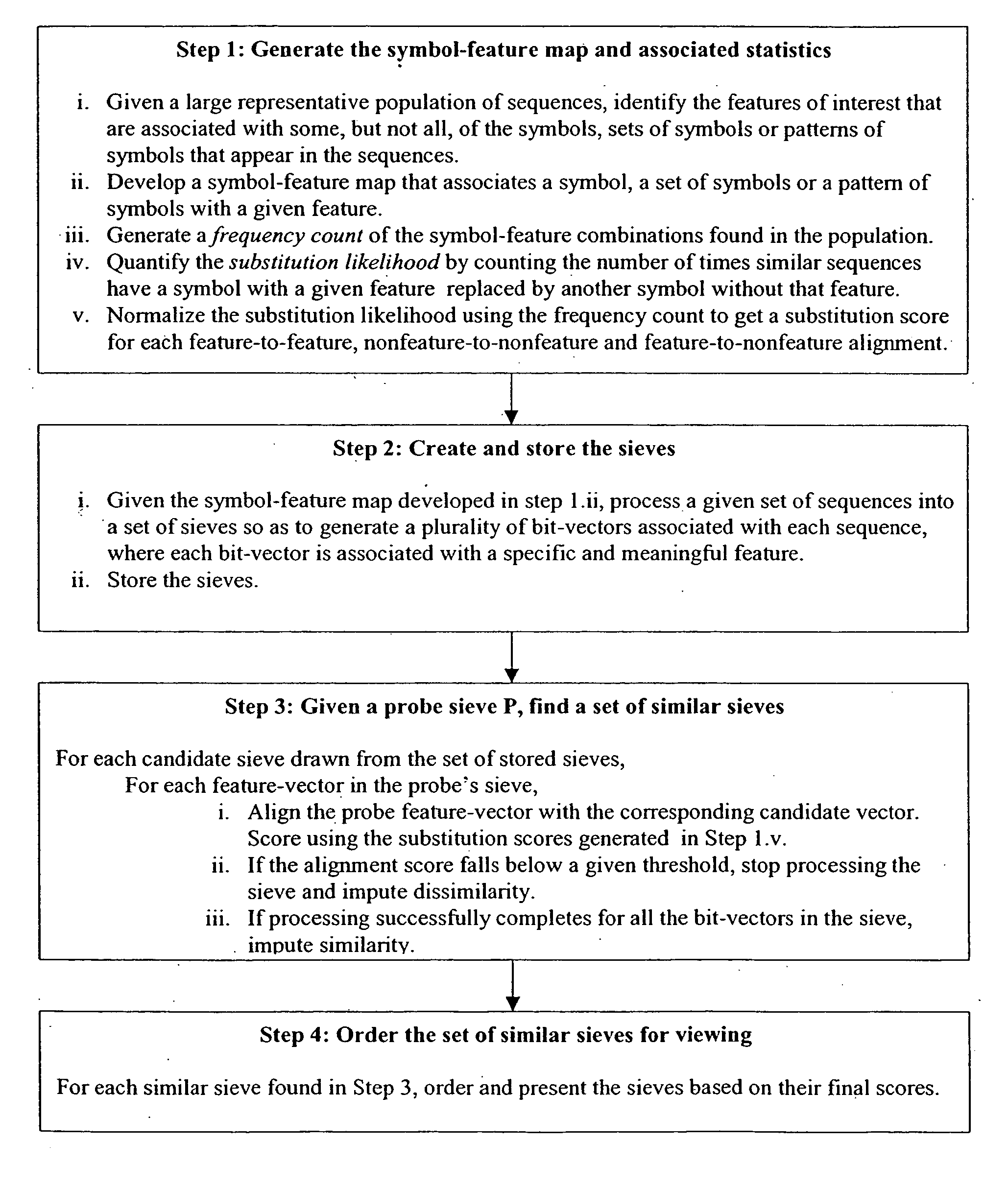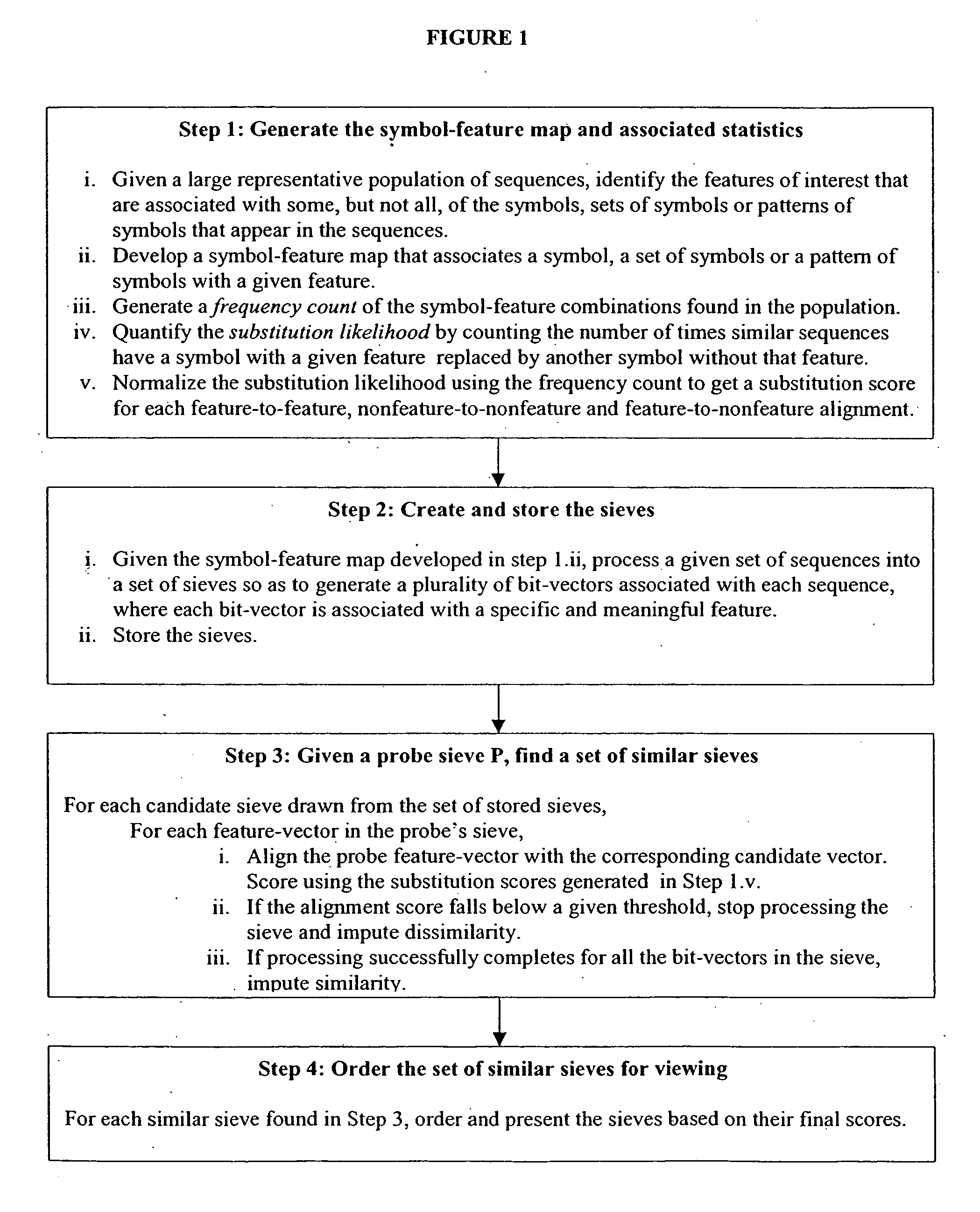System and method for pattern recognition in sequential data
a sequential data and pattern recognition technology, applied in the field of sequential data system and method, can solve the problems of limited application of existing search tools for searching and processing sequential data, including in the fields of bioinformatics and biometrics, and achieve the effects of improving speed, speeding up processing, and facilitating parallel processing
- Summary
- Abstract
- Description
- Claims
- Application Information
AI Technical Summary
Benefits of technology
Problems solved by technology
Method used
Image
Examples
example 1
[0118] This example illustrates that the current system and methods may be successfully utilized in the field of bioinformatics, for the collection, classification, storage, and analysis of biochemical and biological information using computers, particularly as applied in molecular genetics and genomics.
[0119] Nucleotide sequences are typically stored as sequences, often of great length, consisting of the 4 bases A (Adenine), G(Guanine), T(Thymine), and C(Cytosine). For example, a sequence might be:
GATACCTTAGGAACTGAAAAAGGATTCAGGACTG...(SEQ ID NO:1)
[0120] Each of the 4 bases is represented by an alphabetic symbol and such symbols in a computer have typically been stored in previous systems as a byte or block of 8 bit locations, so that a sequence of length N would require 8×N bits of storage space. Searches for alignment are perhaps the most common of all nucleotide sequence analyses and typically consist, for simple local alignments, of trying to match a shorter query (f...
example 2
[0197] This example illustrates that the current system and methods may be successfully utilized in the field of bioinformatics, for the collection, classification, storage, and analysis of biochemical and biological information using computers, particularly as applied in protein analysis and proteomics.
[0198] The primary structure of proteins is represented by a sequence of 20 alphabetic letters corresponding to 20 specific amino acids. An encoding method similar to that used for nucleotides above would require a minimum of 5 digital strings since two to the 5th power is 32 and that is the least power of 2 greater than 20. The specific selection of the encoding may be a assigned by the user and depends upon the intended application. There are more than 24 million distinct ways mathematically to assign a 5-bit code to the 20 amino acids and although only two of these methods are described below as examples, all variations are intended to be covered by this patent.
[0199]...
example 3
Biomolecular Alignments
[0209] A software system for sequence alignment was developed based on 1) the functional decomposition of the initial search string into a set of n bit-vectors that function as feature-vectors in an n-dimensional space, 2) the alignment of probe feature-vectors with text feature vectors using a fast bit-vector algorithm (Myers, G., Journal of the ACM 46(3), 1999), and (3) the scoring of the resultant alignments using a probabilistic distance metric based on the feature space. (see, for example, FIG. 1).
[0210] Because we decomposed probe sequences into collections of feature-based bit-vectors, it was possible to design searches that are both feature-specific and very fast.
The Functional Decomposition of the Search String into a Sieve
[0211] Every binary string in a sieve is a measurement of a feature. The creation of a sieve maps the original symbol sequence into a collection of binary sequences, each exemplifying a different trait of the molecule represent...
PUM
 Login to View More
Login to View More Abstract
Description
Claims
Application Information
 Login to View More
Login to View More - R&D
- Intellectual Property
- Life Sciences
- Materials
- Tech Scout
- Unparalleled Data Quality
- Higher Quality Content
- 60% Fewer Hallucinations
Browse by: Latest US Patents, China's latest patents, Technical Efficacy Thesaurus, Application Domain, Technology Topic, Popular Technical Reports.
© 2025 PatSnap. All rights reserved.Legal|Privacy policy|Modern Slavery Act Transparency Statement|Sitemap|About US| Contact US: help@patsnap.com



